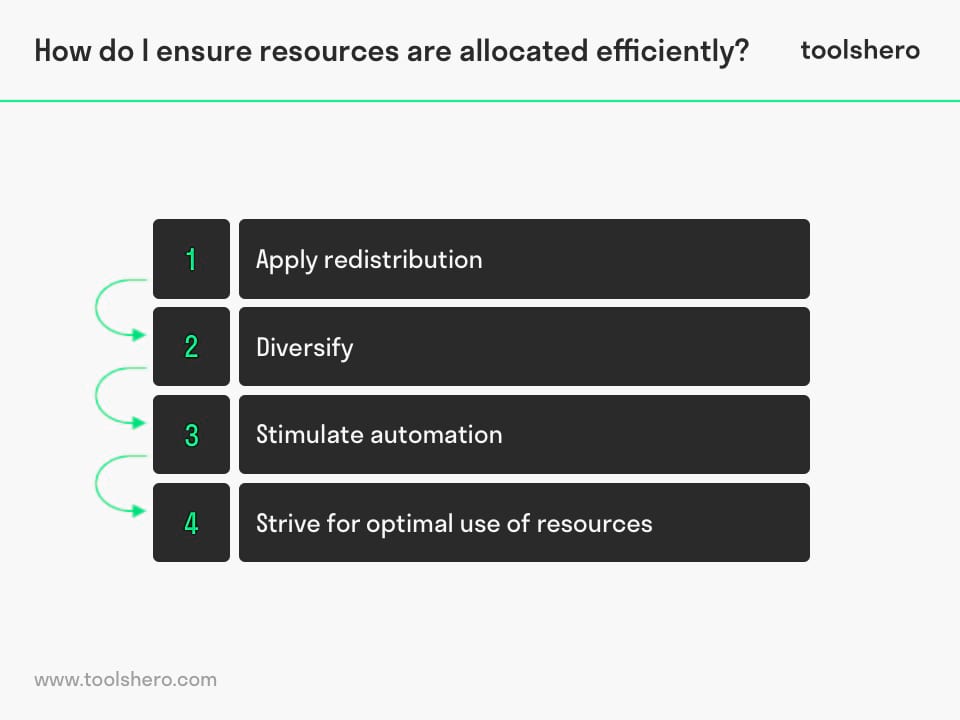Resource Allocation explained

Resource Allocation: this article provides a practical explanation of resource allocation. Highlights include: what resource allocation is, how it is done efficiently, how it is used in practice, what the four production factors are, what scarcity is and what frequently used resources in business are. After reading, you’ll understand the basics of this strategy tool. Enjoy reading!
What is Resource Allocation?
Resource allocation is the process in which a company decides where to allocate scarce resources for the production of goods, creating merch or services. A resource can be considered a production factor that’s used to produce goods or services.
Resources can be many things, including labour, machinery, technology, natural, real estate, financial resources, etc. Resource allocation is a fixed element of a successful project and project schedule.
Effective resource allocations allows for team members of a project to keep momentum and respect project timelines. Strategic resource allocation is important because the project scope can change during its execution phase.
Resource Allocation is a management activity that’s closely related to strategic planning and strategic (resource) management and resource scheduling.
The value of these programmes is in meeting organisational objectives. The relationship between resources and strategy is a two-way street. The strategy determines which resources are required, but the availability of resources can also limit a strategy.
Efficiently allocating resources to the right places is complex and often hampered by a number of factors, including scarcity, financial criteria, organisational politics, ambiguous objectives, risk aversion, and a lack of knowledge and information.
Production factors and Resource Allocation
We mentioned that resources are production factors. These production factors are scarce and are considered essential for all businesses. There are four production factors.
These are land, labour, capital, and entrepreneurship. These inputs are essential for producing output.
At a larger scale, you could say that production factors produce all goods and services within a nation’s economy. The sum of all goods and services is called the Gross Domestic Product (GDP).
Resource Allocation: Land as a production factor
Land as a production factor refers to all natural resources that are available to produce supplies. It includes untreated properties and everything that comes from the earth.
This can also be non-renewable resources, such as oil and gold. Renewable resources, such as wood, are also part of the land production factor.
When people change the condition or composition of land, it becomes a capital good. Crude oil is an example of a natural raw material, while petrol is a capital good as it has been refined. A grassy meadow in the Alps is a natural resource, but the adjacent farm is a capital good.
The income of this production factor, or the reward, is called land interest.
Labour as a production factor
Labour is the second production factor and encompasses all the work done by people. The value of the worker depends on their level of education, skills, and motivation. Productivity is also an important gauge for the success of labour. Productivity measures how much output is produced every hour.
The reward of the labour production factor is wages.
Capital as a production factor
Capital is the third production factor and includes all capital goods, such as machines, chemicals, equipment, and more that are used for the production of goods or services. There is a clear distinction between capital goods and consumable goods.
Capital goods are intended to support production, while consumable goods are the output of the production process. Examples of capital goods are industrial or commercial buildings, or an airline’s aircraft. A private jet is usually not a capital good, since it isn’t used to produce a good or service.
The income that owners receive on capital goods is called interest.
Entrepreneurship as a production factor
Entrepreneurship is the final production factor that’s essential for the production of goods or services.
Entrepreneurship is what drives people to turn an idea into a successful and profitable business. An entrepreneur combines the other three production factors and adds his own entrepreneurship to expand the supply of goods and services.
The income entrepreneurs earn is called profit.
Scarcity
Scarcity refers to a foundational economic problem: the gap between scarce resources and the theoretically limitless needs and desires of consumers. The situation requires that people such as managers and entrepreneurs make choices about how to effectively allocate resources to supply as many consumers as possible with their basic needs, as well as as many additional desires as possible.
Money and time are prime examples of scarce resources. Most people have too little of one, too little of the other, or too little of both.
An unemployed person has lots of time, but little money. A successful manager may be able to retire a little earlier than lower-level employees, but will have had little free time during their working life. People with lots of money and lots of time are rare.
In a hypothetical world in which every resource such as water, expertise, land and food was in abundance, economists would have nothing to study. It wouldn’t be necessary to decide how to allocate resources.
Things work differently in the real world. Everything costs something. In other words, all resources and production factors are scarce to some degree.
Most resources are therefore scarce. This means society (as well as individual businesses) has to make decisions about what to produce and how.
Resource Allocation: frequently used resources in business
The following types or resources are often used in business. The categories are derived from the Business Model Canvas.
Physical resources
Physical resources includes assets such as buildings, machines, vehicles, systems, distribution networks, and production facilities. Retailers in particular are highly dependent on physical resources. These are often capital intensive. Wal-Mart, for example, has a huge network of stores and related logistical infrastructure. Others have extensive IT solutions, warehouses, and logistical infrastructure.
Intellectual resources
Intellectual resources include brands, patents, copyrights, proprietary knowledge, and customer databases. These are becoming increasingly important components of a strong business model.
Resources for intellectual property are hard to develop, but once developed, they offer significant value, usually. Companies like Microsoft and SAP are strongly reliant on knowledge and software for intellectual property.
Human Resources
Every company needs human resources, but some businesses rely on them more than others. Human resources are vitally important in creative or knowledge-intensive industries, for example.
An average pharmaceutical company tends to rely strongly on human resources like highly-trained medical professionals. The business model of a company like this has an army of scientists and competent smart people at its core.
Financial resources
Financial resources include lines of credit, cash, financial sureties, or shares. The financial resources can be used to procure the other resources discussed earlier.
How do I ensure Resource Allocation is done efficiently?
The scarcity of resources poses a major challenge for managers in efforts to improve business. How do I find the right people for the right job? Resource allocation in the workplace is often the diligent allocation of resources to tasks based on requirements, skills, and timelines.
This forces managers to allocate these based on a specific situation rather than that it’s a purely strategic choice. Applying practices for effective resource management can make a big difference.
One of the methods is the optimising of the extent to which all involved resources are available. In addition, there has to be a focus on the visibility of resources. We’ll discuss these methods in more detail and offer some tips below.

Figure 1 – steps for setting up Resource allocation
1. Apply redistribution
It’s important to make room for strategic redistribution. This is a good first step. Reallocation doesn’t mean that the work being done with an assignment of resources becomes strained.
Strategic reallocation means looking for alternatives to get some extra manpower who can take on more responsibility. This way or reallocation is strongly dependent of the overall visibility of projects and resources. This is essential to employ staff optimally.
2. Diversify
It’s always good to have resources and staff equipped with a broad range of skills, or who are used to performing different tasks. Therefore it’s hugely important that managers recognise and cherish both primary and secondary skills.
If the manager is aware of the abilities of their resources, he or she can quickly resolve any problems that may arise by making the right resources available in the right places.
Take an engineer at a pharmaceutical company, for example. This guy also minored in communication, and vlogs in his spare time. He could be a big asset for the internal marketing department. In addition to product knowledge and knowledge of the technical aspects of the production process, he can also add value to the company’s branding.
This is also good for the employees themselves. Nobody likes to stagnate, and employees will be motivated when given the opportunity to diversify and grow. A good manager doesn’t just understand this concept, but also applies it in his strategy for resource allocation.
3. Stimulate automation
One of the most obvious challenges when allocating resources is the complicated process managers have to comply with when they want to assign new resources to new tasks. This often involves multiple phone calls, email messages, or sending requests to other managers.
An automated resource-allocation process is a special route by which managers can do this independently within a certain scope.
Combined with visibility and transparency, valuable time can now be allocated in other areas. Furthermore, a streamlined process makes it easier to monitor which resources were allocated to which department. This prevents the confusion that can arise when resources cannot be traced.
4. Strive for optimal use of resources via Resource Allocation
Optimal use of resources means a healthy resource-allocation process. When the use and allocation level of resources is optimal, this means that under no circumstances are too many or too few resources being used.
As a result, the output produced by the company is created as efficiently as possible. Optimal use of resources should be the overall result, rather than a lucky outcome. Each method that is used to allocate these has to meet this criterion.
Resource management in practice
Allocating resources to the right departments is part of resource management. Resource management includes the planning, tracking, and optimising of the use of resources such as space, equipment, and personnel.
This process covers planning and management, checking resources, planning start and end dates for certain projects and resources, conflict management, and regular monitoring to be able to implement any needed changes in a timely manner.
Resource allocation and resource management software
Naturally, resource allocation is relatively easy in smaller companies. Larger companies require more tools. One such tool is so-called resource management software. This is also referred to as planning software for resources.
The software is similar to project management software used by managers to plan, allocate resources, and monitor who is working on what project and what resources are needed.
Effective use of such software makes it easy to track the organisation’s capacity in terms of resources and available skills and report on this. It also makes it easier to analyse historical results and use those to make forecasts regarding resource usage.
Advantages of resource management software:
- The most efficient and effective use of resources
- Provides a complete picture of an organisation’s capabilities. It prevents overbooking and can be used as an argument for certain recruitment decisions
- Prognoses about the future become more accurate when analysing historical data
Now it’s your turn
What do you think? Are you familiar with the explanation of resource allocation? Are you involved with resource management? Are resources used optimally where you work? Do you ever run into issues related to the effective allocation of resources? What do you consider important in resource management?
Share your experience and knowledge in the comments box below.
More information
- Bazzaz, F. A., & Grace, J. (Eds.). (1997). Plant resource allocation. Elsevier.
- Harberger, A. C. (1995). Monopoly and resource allocation. In Essential Readings in Economics (pp. 77-90). Palgrave, London.
- Trigeorgis, L. (1996). Real options: Managerial flexibility and strategy in resource allocation. MIT press.
How to cite this article:
Janse, B. (2020). Resource Allocation. Retrieved [insert date] from Toolshero: https://www.toolshero.com/strategy/resource-allocation/
Original publication date: 05/15/2020 | Last update: 10/24/2023
Add a link to this page on your website:
<a href=”https://www.toolshero.com/strategy/resource-allocation/”> Toolshero: Resource Allocation</a>












